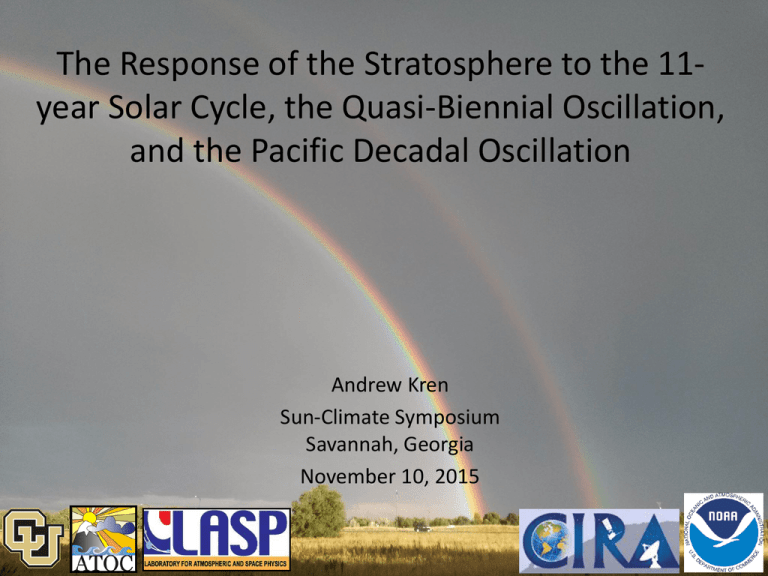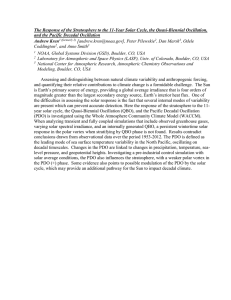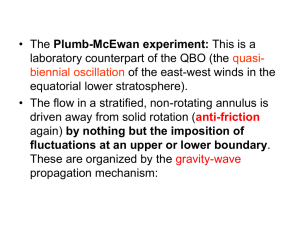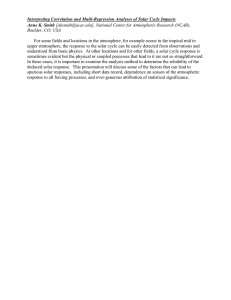The Response of the Stratosphere to the 11-
advertisement

The Response of the Stratosphere to the 11year Solar Cycle, the Quasi-Biennial Oscillation, and the Pacific Decadal Oscillation Andrew Kren Sun-Climate Symposium Savannah, Georgia November 10, 2015 Climate change prediction and “hiatus” What is driving stall in rise of global temperatures since 2000? Earth System Models of Intermediate Complexity IPCC [2013; Figure 9.8] 2 Natural forcings of climate Pacific Decadal Oscillation The Sun Quasi-biennial oscillation SORCE and SOLSTICE 230 nm SSI TSI 0.1% ~ 5% HadISST Earth’s response to solar variability wavelength dependent 3 Science questions and motivation Motivation -> Investigate Sun’s impact on Earth system • What is the role of varying solar spectral irradiance (SSI) in decadal climate variability? • What is the role of the 11-year solar cycle and quasi-biennial oscillation (QBO) in influencing the northern polar stratosphere? • Does the pacific decadal oscillation (PDO) influence the northern polar stratosphere and is it modulated by variable solar forcing? 4 Solar Irradiance: Largest Energy Source Earth’s Energy Sources (Log scale) Solar Irradiance 100.00 W m-2 340.25 W m-2 10.00 1.00 TSI 0.1% 0.34 W m-2 0.129 W m-2 0.10 All other sources Kren, A. C., (2015), Investigating the role of the Sun, the quasi-biennial oscillation, and the pacific decadal oscillation on decadal climate variability of the stratosphere, PhD thesis. 5 Top-down and bottom-up solar forcing thermosphere TSI 0.1% mesosphere stratosphere troposphere SH Bottom-up Mechanism UV > 6% Top-down Mechanism T O3 QBO ∆U ∆U,T Walker & Hadley Cell PDO ENSO oceans Equator AO, NAO surface NH 6 Proposed Solar and QBO interaction on high latitudes QBO Modified wave propagation Zonal wind anomaly in subtropical upper stratosphere Solar Cycle Modulation of upper stratospheric jet at midlatitudes Zonal wind anomaly in subtropical upper stratosphere Solar Cycle and QBO Zonal wind Anomalies enhanced or diminished Poleward – downward propagation Weaker vortex in Smax/QBO west [Kodera, 1991; Gray et al., 2004; Matthes et al., 2013] 7 Motivation Compositing 30 hPa geopotential heights at North Pole as function of solar cycle and QBO phase [Labitzke and Kunze, 2009] 8 Whole Atmosphere Community Climate Model (WACCM) Model Parameters Case 1: 1850 – 2005 (WACCM4a) Case 2: 1850 – 1943 (WACCM4b) Vertical resolution 66 levels, surface to lower thermosphere (5.1 x 10-6 hPa) Horizontal resolution 1.9° latitude by 2.5° longitude Atmospheric dynamics Interactive ocean, sea ice, chemistry Volcanic activity Specified Greenhouse gas forcing Transient 20th century simulations Solar forcing Annual mean SSI [Lean et al., 2005] scaled to TIM [Kopp and Lean, 2011]. QBO Internally generated, QBO at 30 hPa 9 Reproducibility of observed QBO Amplitude and Descent Westerlies > 5 m/s Easterlies < - 10 m/s 10 Stratospheric Solar cycle response in WACCM to solar cycle Composite Solar Max – Solar Min This study [Austin et al., 2008] 11 Prior research suggests QBO modulation by solar cycle… Wavelet analysis QBO Period QBO variation and UV spectral irradiance 12 Solar and QBO interaction on high latitude winter Composite and correlation analysis Model/Obs. Period QBO East QBO West n (East) n (West) WACCM4a 1850 - 1890 -0.04 [0.89] 0.22 [0.36] 11 18 WACCM4b 1850 - 1890 -0.17 [0.58] -0.13 [0.57] 11 18 WACCM4a 1891 - 1931 0.06 [0.83] 0.43 [0.08] 16 18 WACCM4b 1891 - 1931 -0.24 [0.34] 0.04 [0.87] 16 18 WACCM4a 1932 - 1972 -0.07 [0.77] -0.04 [0.87] 16 17 WACCM4a 1973 - 2005 0.00 [0.98] -0.47 [0.09] 13 14 NCEP Reanalysis 1953 - 2005 -0.09 [0.73] 0.61 [0.001] 14 28 NCEP Reanalysis 1953 - 2012 -0.18 [0.47] 0.36 [0.04] 16 33 13 Solar and QBO interaction on high latitude winter Monte Carlo sampling Time-mean response of stratosphere to solar and QBO forcing 1. Winters (DJFM) randomly sampled from both WACCM cases (249 winters) 2. Each winter month, group years into QBO East and West 3. 16 East and 33 West randomly selected to match observational period 1953-2012 4. Compute correlation between 30 hPa heights at north pole and 255 nm irradiance. 5. Repeat a million times to get normalized R correlation 14 Solar and QBO summary • Examining Solar response in the stratosphere • WACCM simulations with internally generated QBO • Warming of ~ 0.5 K in tropical upper stratosphere • Solar modulation of QBO period or amplitude not found • Solar-QBO relationship on high latitude winter • Correlation found over selected 40-yr periods of QBO west • Time-mean response not significant • Chance occurrence of solar-QBO correlation Kren, A. C., D. R. Marsh, A. K. Smith, and P. Pilewskie (2014), Examining the stratospheric response to the solar cycle in a coupled WACCM simulation with an internally generated QBO, 15 Atmos. Chem. Phys., 14, 1-14. PDO Methodology WACCM Simulation Hadley Centre SST dataset (HadISST) 1850 control simulation (200 years) 1900-2014 period Volcanic activity None Greenhouse gas forcing 1850 pre-industrial levels Solar forcing Fixed SSI at solar avg QBO None Monthly SSTs 1˚ resolution 16 DJF PDO spatial pattern Principal Component Analysis 17 Winter PDO signature in the stratosphere December Composite PDO (+) – PDO (-) 500 hPa 100 hPa 10 hPa 3 hPa 18 Potential PDO modulation by solar cycle Peak solar max year and DJF and JF PDO phase in HadISST Peak Solar Year DJF PDO JF PDO 1907 -0.32 -0.43 1917 -1.07 -1.01 1928 0.34 0.70 1937 0.33 -0.22 1947 -0.55 -0.38 1957 -1.04 -1.19 1968 -0.55 -0.42 1979 -0.50 -0.54 1989 -0.93 -1.3 2000 -1.32 -1.24 2013 -0.92 -0.79 19 PDO summary and future work • PDO stratospheric signal • • • • WACCM PDO can reproduce observed PDO Hemispheric and zonal mean warming over polar region in PDO (+) Contamination between PDO and ENSO Future study beneficial to examine interplay between PDO and ENSO • Solar forcing of PDO and “hiatus” • Future study needed to investigate PDO modulation by solar cycle • Decadal climate prediction can be aided by understanding PDO Kren, A. C., D. R. Marsh, A. K. Smith, and P. Pilewskie (2015), Wintertime Northern Hemisphere response in the Stratosphere to the Pacific Decadal Oscillation using the Whole 20 Atmosphere Community Climate Model, J. Climate, in review. Sensing Hazards with Operational Unmanned Technology (SHOUT) 1. Targeting winter storms affecting Alaska and U.S. 2. Regions sensitive to added dropsonde data 3. Real-time support for Global Hawk – improve forecasts 21 Thank you All other sources of energy Solar and non-Solar Originally presented in Sellers [1965] Energy Source Solar Irradiance Flux Density [W m-2] 340.25 Relative to Total Solar Irradiance 1.000 Secondary Sources of Solar Origin Anthropogenic Heat 0.028 Flux Infrared Radiation 0.012 from Full Moon Reflected Radiation 0.0038 from Full Moon Airglow Emission 0.00349 Auroral Emission 0.00252 Solar Atmospheric 0.00165 Tides Magnetic Storm 0.001 Dissipation Zodiacal Irradiance 5.65E-05 Lightning Discharge 8.6E-06 to 8.6E-05 Energy Earthshine 3.08E-07 Total 0.053 8.2E-05 3.5E-05 1.1E-05 1.03E-05 7.4E-06 4.8E-06 2.9E-06 1.66E-07 1.4E-07 Energy Source Solar Irradiance Flux Density [W m-2] 340.25 Relative to Total Solar Irradiance 1.000 Secondary Sources of non-Solar Origin Earth’s Interior 0.06 to 0.092 2.2E-04 Heat Flux Cosmic Radiation 3.51 to 7.42E-05 1.6E-07 Lunar Tides 1.89E-05 5.6E-08 Dissipation of Energy of Micrometeorites 3.8E-07 1.1E-09 Extragalactic Light 1.26E-08 3.7E-11 0.076 2.2E-04 Total 9.1E-10 1.6E-04 Kren, A. C., (2015), Investigating the role of the Sun, the quasi-biennial oscillation, and the pacific decadal oscillation on decadal climate variability of the stratosphere, PhD thesis. 23




